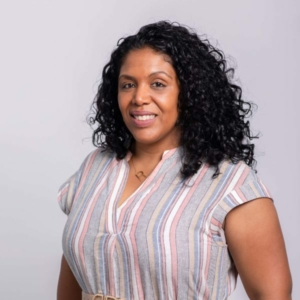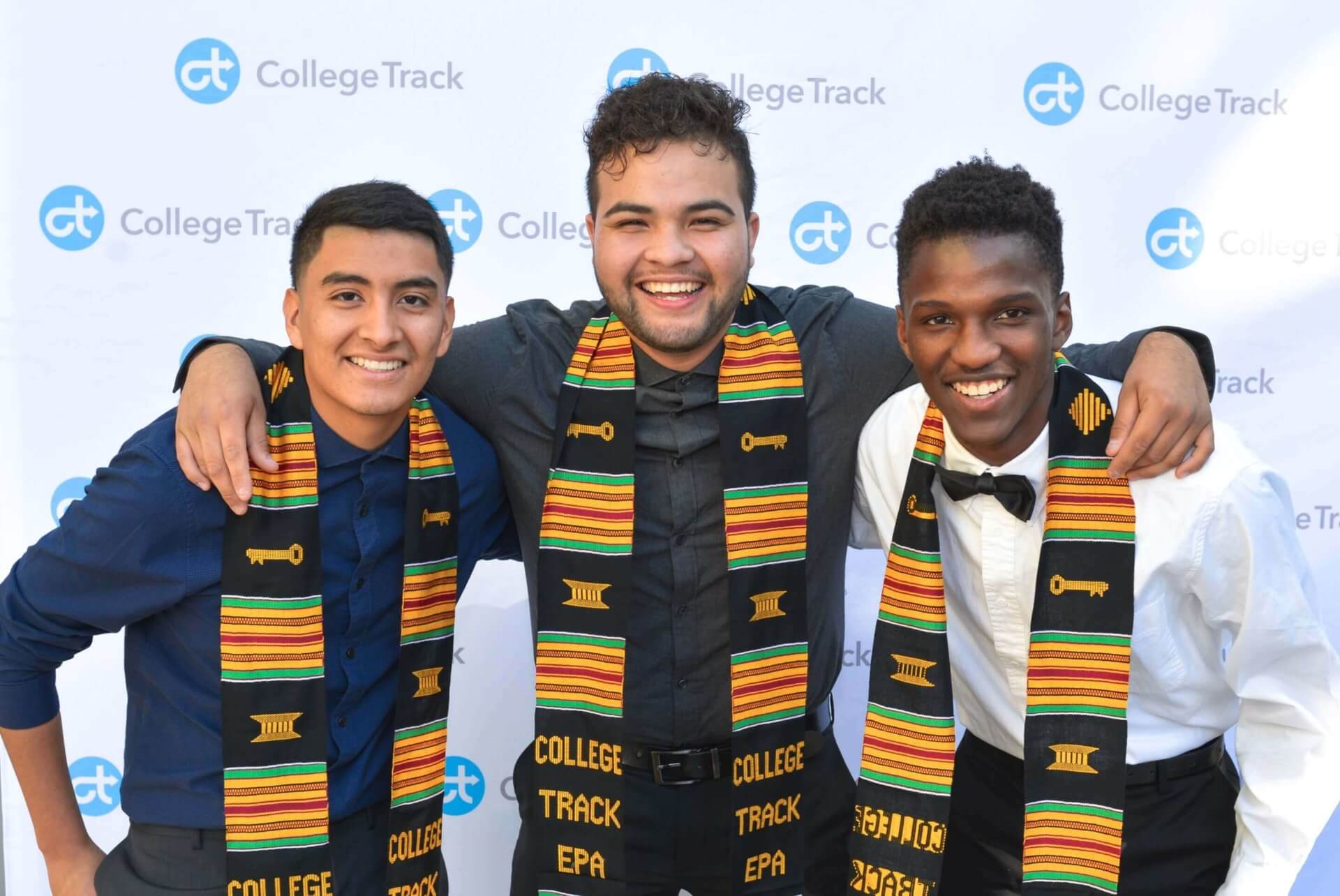College Track is celebrating its 25th year of equipping first-generation college students from underserved communities to be the first in their family to earn a bachelor’s degree. Since we first wrote about College Track in 2017, the organization has expanded both its student centers and its advocacy for programming to support first-gen students in college. Today, College Track operates 12 high school student centers in California, Colorado, Louisiana, and the D.C. Metro Area, and its college scholars can be found on nearly 240 higher ed campuses around the country.
Initially, College Track was solely focused on college access, but it has evolved over the years to commit to a 10-year partnership with every scholar, from ninth grade through college graduation and on to launching their careers. College Track’s new leadership brings extensive experience at higher education institutions to direct the expanded scope.
College Track is very good at what they do. Ninety-eight percent of College Track’s high school scholars are accepted to four-year colleges or universities, and nearly 90% of them matriculate. Approximately 10% choose to attend a two-year school after high school. For these students, College Track is developing and piloting a “community college playbook” to support their successful transfer to a four-year school. Koret values access to all post-secondary pathways, and our recent grant will support this pilot project. College Track scholars, whether they begin their college careers at a two- or four-year institution, earn their bachelor’s degrees at a rate 2.5 times greater than their first-gen peers from low-income households.

We recently had a chance to speak with Dr. Rosanna Ferro, College Track’s first Chief of Education. Dr. Ferro herself is a proud first-generation college student and an immigrant. She talked about her experience with the barriers that many first-generation college students face—and how College Track is working to ensure that students have the “ability and responsibility to influence their own destiny.”
College Track
Scholar Success & National Impact
Student Center Locations:
California, Colorado,
Louisiana, D.C. Metro Area
Scholars accepted to four-year
colleges or universities
98%
Four-Year College
Matriculation Rate
90%
College Track Scholars
students of color
99.85%
From low-income families
84%
First generation to attend college
90%
KF: How does your experience in higher education translate or connect to College Track’s long-term priorities?
Our strategy now more than ever is about systems change. We are both empowering our students to be the amazing scholars they are, and we are also asking institutions to take a hard look at their programs for supporting first-generation students. We have been saying, “If you are really going to partner with us, and we are going to expose our students to who you are as an institution, you need to be ready for them. Because they’re going to come and challenge whatever the preconceived notions are about what it means to be a first-gen student, and especially to be a College Track scholar.” I’ve seen what happens to our scholars at institutions that don’t get it—and I’ve seen what can happen at institutions that do.
I worked for several years at Williams College, setting up their first ever comprehensive first-generation program. We were able to transform the way the institution perceived and embraced first-generation students. And that led to transforming the way students saw themselves in the space. That program has now been endowed. And then at Ithaca College, I also spearheaded the launch of the first-generation center there. That work was in a sense a precursor to what we are expanding College Track to encompass. We pair every college scholar with a College Track Thrive Coach, many of whom are first generation themselves, or have done other work on college campuses. Our staff believes deeply in the work that we do and the effect it can have.
KF: How can colleges and universities themselves change—and we all know that academia’s pace of change is often described as glacial—to better support College Track and other first-gen students?
Colleges and universities have begun to invest in ways to support first-gen students. The next step is to help students feel that they belong, that they are adding to the community, not that they are an afterthought. How does the leadership of an institution, and the faculty, speak about students that come from first-gen backgrounds? The language that you use to implement your practices matters. Take emergency funding. There can be a tendency to require students to ‘prove how poor they are,’ rather than framing it as, “This is a resource available to all students. You don’t have to justify your need. We’re going to believe you and not further traumatize you—because you’re going through something already.” So, there needs to be a philosophical shift in the institution’s thinking, in the approach. You’ve invested all of these resources to bring these amazing students onto your campus. Why would you do certain things that are going to automatically turn them off, so they’re going to want to run the other way? Why not think about retention of these students differently?
KF: And can you effect this scope of change from outside of academia?
Yes, we can. It’s actually about creating shared responsibility for the success of our scholars while they’re at these institutions. We want to hold the schools accountable if we are going to be advising students to apply to any given college or university. We are having conversations with the top layer of leadership, the presidents and chancellors and VPs of enrollment. We ask them to tell us about their mission and what they are prioritizing. We want to understand what types of programs they already have in place. Our goal is not to replace, but to complement and enhance how they support their students. Ultimately, it is each school’s responsibility. Systems change is really pushing that line. That’s why we consider the work we do a movement to democratize potential. It’s not good just for College Track scholars, it’s good for any student, regardless of their background, for institutions to take a really hard look at their practices, how they approach students and issues. We’re also bringing along amazing institutions that have great leadership, people who want to do this work, and are willing to think beyond themselves and What’s good for my institution?
KF: And how have College Track high school students fared—especially during the pandemic—in terms of staying on track toward their goals? We have read a lot about how college applications from first-gen students have plummeted.
This is true overall, but much less so for College Track scholars. Our matriculation rate dipped slightly for 2020, but completely rebounded in 2021 to our previous years’ levels. We didn’t see a significant increase in students taking a gap year. Our persistence level (graduation rate) hasn’t quite returned to pre-Covid levels, but we expect it to. We’re still battling the reality that’s out there, in terms of Is a college education worth it? That is one of the biggest questions. There’s been a lot of judgment and digs at higher ed, like, Why should I be paying all this money to get a college degree when I can go and develop my own career in something that hasn’t even existed before? That is all true, and it is actually possible. But the chances are low.
We’re honest with our scholars about that, and that’s why the ninth- and tenth-grade program is so critical. For us, it is about socializing students to the idea of college, wherever they are in their thinking. The ninth- and tenth-grade program is pre-college. We pay attention to Who are you as a person? What are your dreams? What are your aspirations? We don’t ask, What do you want to major in at college? Because at that age, you’re not thinking that way, first and foremost. The program involves a lot of purpose development.
KF: How about rates of college completion and how long it takes College Track students to earn their degrees?
We know that the longer you stay at a college or university, the greater the risks to degree completion. There are so many things that can happen after your fourth year. For instance, you might run out of funding. And we want to be sure that we’re not getting our scholars into that space where they’re having to step out, or take time away, or reverse transfer to community college.
The national six-year graduation rate for first-generation college students is 21%. College Track scholars are graduating over 50%, which is impressive, but we are not settling. We know our scholars have tremendous potential and with our intentional approach that percentage will continue to rise. Still, we’re two and a half times the national average, which is impactful. Part of what is so high-touch, especially with our college program, is that we are digging deep into what’s happening for our scholars individually. If we see a scholar struggling, it could be so many things. We will connect them to the right resources on their campus. Is there something else happening here that we can help them with? And oftentimes it’s a combination of things. And we monitor GPA, both in high school and in college—agreeing to that is part of the student’s commitment to the program.
KF: We know that College Track’s goal, your curricular and counseling emphasis, is on getting students into four-year schools, but what about the students who choose to go to community college?
We have a small percentage of students—currently about 10%—who go this route. In those cases, we really look at community college as a start, but not a destination. We want to make sure that it’s a community college that makes sense, with some support systems built in, and then we complement what the school does. We are also simultaneously helping students keep that four-year college in sight, so they aren’t feeling that this is not an option anymore. We are there to help students sort things out—with finances and with academics. Sometimes students are making their choice with the mindset, “I can’t afford four years of this, even with an amazing package.” We assist them with building a support network and layer it while they’re going through this experience, which might just be a one-year experience, or maybe it’s one semester to sort some things out.
KF: And you are identifying and looking to partner with community colleges that are particularly open to College Track’s objectives in this regard?
We have been working with some already, in particular in the Bay Area. This is a great region to pilot this, not just thanks to our ongoing support from Koret, but also because there is such a mixture of institutions that are geographically relatively close to our scholars, for them to choose from. For example, some scholars need to stay close to home for various reasons. At times it may make sense for them to start at a two-year program, but then the goal is for them to transfer to a four-year college. An additional factor is that we have several College Track sites in the Bay Area, giving us a large pool of students to work with on this. We only have a few scholars at any given community college—in some instances only a handful. This is why our new community college “playbook” will be useful in the Bay Area to start, and then we can broaden it to other areas where applicable.
College Track scholars in New Orleans come together to celebrate their college acceptances.





